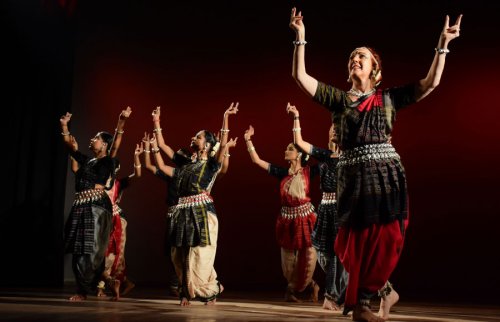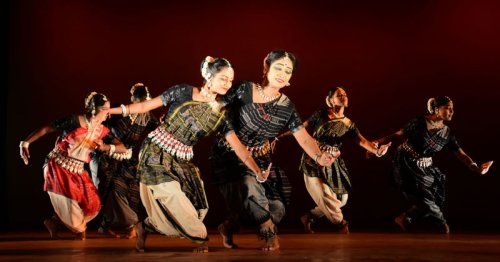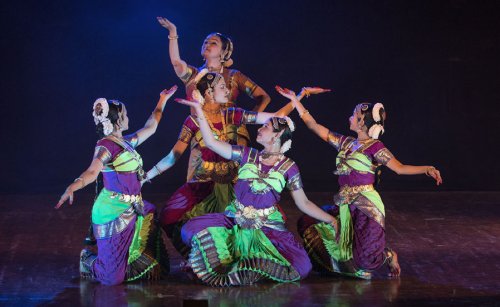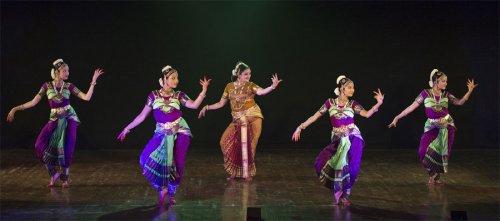
|   |

|   |
 e-mail: ukb7@rediffmail.com Creativity in classical orbs October 23, 2018 Is the spinning earth spinning out of control with its overload of human problems? Large segments of humanity, swathed and overwhelmed under depraved conditions -- without any fault of theirs -- are virtually beggars at the doors of the more fortunate and the affluent. At the other end, is the gap between the world of artistic expression and this horrific social reality of today's world becoming an over-widening chasm? Is our artistic reaction to our times aimed at all towards interpreting the ever-widening divisions created by hate and greed, through art's message of peace and harmony? Can Indian classical dance, in particular, play a role -- as was poignantly asked by the dance connoisseur Anita Ratnam, in one of her recent perceptive comments -- beyond depicting endlessly the images and icons to the tunes of the ethereal song, Krishna ni begane baro...? Sangam presented on September 29 in Bhubaneswar by Art Vision, took up this challenge. Celebrating ten years of a confluence of dances, the festival had begun in 2005 and continued usually by depicting innovative themes in Odissi. Beginning with Ganga Yamuna based on a canto from Kalidasa's Raghuvamsa - and influenced by an earlier production by Chandralekha - the festival showcased in 2007 Bolero where Ravel's Western music met Indian Odissi. 2008 saw Mahanadi depicting the river that formed the lifeline of Odisha. The 2009 production Jalai Rakha captured the essence of a modern Oriya poem: Whenever darkness submerges you... I will tell you the secret of a glowing lamp whose shift of life refuses to die... In 2010, Karuna -- which this critic saw -- was inspired by Mother Teresa, and her concerns and care for the marginalised in the society. Kaala - Timebound in 2012 reflected the IGNCA's visual narrative on the movement of Time, in a language of geometry using linearity, concentric circles, cones, squares and triangles. Gaia - Mother Earth came in 2013 as an Odissi-Chhau experiment, based on a folktale that caressed Nature and a fostering care for environment. The glorious climax was Herman Hesse's Siddhartha, narrated in Oriya poetry, on the protagonist's spiritual journey in search of a deeper meaning of life. The guiding spirit of Sangam and Art Vision has been the Italian dancer Ileana Citaristi whose years of experience in the experimental theatre in Europe is backed by grooming in Odissi by the legendary Guru Kelucharan Mohapatra and in Mayurbhanj Chhau under Guru Hari Nayak. With her doctoral work on psychoanalysis and eastern mythology, Ileana demonstrated her early penchant for innovative choreography in Chhau by staging the Greek myths Echo and Narcissus (1985) and Icarus (1991), both of which this critic had seen and favourably reviewed.   Refugee Refugee, the first presentation this year took the very legitimate position that for many thousands of years, man's travel paths were free like a bird's flight. The human traveller on land - or a sailor on the seas - was free to reside wherever he reached. In the changed world of today, thousands of innocent and non-aggressive people are becoming refugees every moment with their earth dissected and their geography scuttled. They have no address of their own. They move on relentlessly in sand and snow, along railway tracks and in shaky sailing boats. Under Ileana's steering as a lead, ten dancers begin in their happier days, with the lyric: There were the spring blossoms, it was all fragrant: our homes, our town... Then the catastrophe occurs: Suddenly there was fire, and smokes of gun powder; in a heart rending shrill, sleep vanished... They lose their address: Your letter returns without touching my hands... The sojourners have now lost their calling: In the sky here, there are no known moon and stars... There is relentless walk towards nowhere: In between the hills flows the river made of stones... They are virtual beggars now, moving in circles and arcs, like hapless pilgrims who have lost their prophet: There is no way to go back, a screen of smoke is the only tryst we have with fate... Still, could there be hope somewhere: If all the hatred in the hearts all over the world would ever dissolve in defeat... It was a riveting idea, with bold choreography charting new frontiers. Devdas Chhoutray's script of poems was compelling and Laxmikanta Palit's music rose to the occasion. The dancers Sagarika, Minati, Upasana, Mousumi, Dibya, Kashish, Shrutirekha, Priyanka, Priyadarshini and Subhasri, supporting Ileana, were all very well groomed.   Artha Shringara Artha Shringara directed by Sandhya Purecha, followed as another highly innovative item, derived from her research on theory and practice of Kalasa Karana and Sthanaka-Mandala Bheda. Sandhya developed her present dance production based on the 13th century treatise Nritya Ratna Kosha by Kumbha Raja, which evolved innovative movements of the Kalasa Karanas, not mentioned in any other text. As desi Karanas and very different from the well-known 108 margi Karanas - mentioned in Bharata's Natya Shastra -- they could probably be termed as Anukaranas: that is, imitative movements inspired by Nature. There were, in all, six types proposed by Kumbha Raja: Vidyut (lightning), Khadga (dagger), Mriga (deer), Baka (crane), Manduka (frog) and Hamsa (swan) Kalasas, with each of them permissive of several variations in their movements. Again, with each Kalasa and its variations, one could narrate a story while delving into the theory and evolve an entirely new practice! Indeed, Sandhya did precisely the same; namely, weave the subtle and elegant movements of the Kalasa Karanas into Kalidasa's lyrical poetry of Ritu Samhara (The Gathering of Seasons). Together with Sandhya herself, her dancers Chitra, Mandira, Pushkara, Shambhavi, Mihika and Shravani - as a well-trained ensemble - visualized the epic Sanskrit poetry, magnificently describing the grandeur of nature. Aimed at arousing those feelings that are awakened by the changing seasons in every pair of lovers, they depicted Grishma (summer) and Varsha (the rains) and invoked graphically the Khadga, Manduka and Vidyut Kalasas in their story-telling. Unfortunately, due to pressure of time, they had to hurriedly transit into the last season, Vasanta (spring), and could still establish Mriga, Baka and Hamsa Kalasas in their narratives. In the recorded music, vocal rendering by Manoj Desai and Aparna Desai was a great support, with overall music direction by Manoj Desai. All kudos to Sandhya for imparting new dimensions into her classical forte of Bharatanatyam, especially recalling that she had already done a very creditable solo-rendering of the 108 margi karanas, under her Guru Parwati Kumar, and recorded them at the IGNCA for the aesthetic pleasure of all dance lovers, also viewed by this critic.  Dr. Utpal K Banerjee is a scholar-commentator on performing arts over last four decades. He has authored 23 books on Indian art and culture, and 10 on Tagore studies. He served IGNCA as National Project Director, was a Tagore Research Scholar and is recipient of Padma Shri. Post your comments Please provide your name and email id when you use the Anonymous profile in the blog to post a comment. All appropriate comments posted with name & email id in the blog will also be featured in the site. |